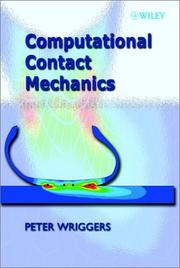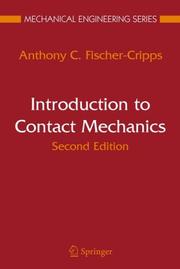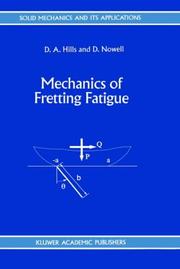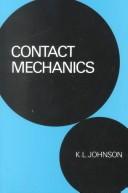| Listing 1 - 10 of 26 | << page >> |
Sort by
|
Book
ISBN: 0128217995 0128218053 9780128218051 9780128217993 Year: 2022 Publisher: Amsterdam, Netherlands ; Oxford, England ; Cambridge, Massachusetts : Elsevier,
Abstract | Keywords | Export | Availability | Bookmark
 Loading...
Loading...Choose an application
- Reference Manager
- EndNote
- RefWorks (Direct export to RefWorks)
"Discrete Contact Mechanics with Applications in Tribology presents new solutions to contact problems for elastic and viscoelastic bodies in normal, sliding, and rolling contact, taking into account effects such as surface microgeometry, adhesion, fluid films, and viscous hysteresis in bulk material or surface layers. These solutions are applied to problems in tribology for modeling contact and friction of bodies with surface microgeometry (rough or textured)."--
Contact mechanics. --- Contact problems (Mechanics) --- Mechanics, Contact --- Mechanics, Applied --- Tribology.
Book
ISBN: 3038429805 Year: 2018 Publisher: Basel, Switzerland : MDPI,
Abstract | Keywords | Export | Availability | Bookmark
 Loading...
Loading...Choose an application
- Reference Manager
- EndNote
- RefWorks (Direct export to RefWorks)
The desired properties of surface components include the improvement of different properties, such as aesthetic appearance, oxidation resistance, wear resistance, mechanical properties, electronic or electrical properties, thermal insulation, wear, triboemission and corrosion resistance through barriers. These properties can be enhanced using different methods, such as by adding a coating. Nevertheless, the bulk of the material or substrate cannot be considered independent of the surface treatment. Metal cutting is one of the general machining methods used to achieve high accuracy and productivity for metal parts. The topics of the book "Manufacturing and Surface Engineering" include the full range of surface engineering aspects, i.e., surface integrity, contact mechanics, friction and wear, coatings and surface treatments, multiscale tribology, computational methods, and optimization techniques applied in surface engineering.
Contact mechanics. --- Contact problems (Mechanics) --- Mechanics, Contact --- Mechanics, Applied
Book
ISBN: 3030851745 3030851753 Year: 2022 Publisher: Cham, Switzerland : Springer,
Abstract | Keywords | Export | Availability | Bookmark
 Loading...
Loading...Choose an application
- Reference Manager
- EndNote
- RefWorks (Direct export to RefWorks)
This book contains contributions from leading researchers in biomechanics, nanomechanics, tribology, contact mechanics, materials science and applications on various experimental techniques including atomic force microscopy (AFM) for studying soft, biomimetic and biological materials and objects. Biologists, physicists, researchers applying methods of contact mechanics and researchers testing materials using indentation techniques along with many other applied scientists will find this book a useful addition to their libraries. Moreover, several reviews in this book are written as introductions to several important and rather sophisticated research areas such as depth-sensing indentation, studying of biological cells by AFM probes, mechanics of adhesive contact and contact between viscoelastic (hereditary elastic) solids. The book containing new theoretical models, results of experimental studies and numerical simulations, along with reviews of above mentioned areas of contact mechanics in application to biological systems, would be beneficial for researchers in many areas of biology, medicine, engineering, mechanics and biomimetics.

ISBN: 0471496804 Year: 2002 Publisher: New York, NY : John Wiley,
Abstract | Keywords | Export | Availability | Bookmark
 Loading...
Loading...Choose an application
- Reference Manager
- EndNote
- RefWorks (Direct export to RefWorks)
531 --- General mechanics. Mechanics of solid and rigid bodies --- 531 General mechanics. Mechanics of solid and rigid bodies --- Contact mechanics --- Contact problems (Mechanics) --- Mechanics, Contact --- Mechanics, Applied --- Mathematical models --- Contact mechanics - mathematical models

ISBN: 0387681884 0387681876 1441943269 Year: 2007 Publisher: New York : Springer,
Abstract | Keywords | Export | Availability | Bookmark
 Loading...
Loading...Choose an application
- Reference Manager
- EndNote
- RefWorks (Direct export to RefWorks)
Introduction to Contact Mechanics, Second Edition is a gentle introduction to the mechanics of solid bodies in contact for graduate students, post doctoral individuals, and the beginning researcher. This second edition maintains the introductory character of the first with a focus on materials science as distinct from straight solid mechanics theory. Every chapter has been updated to make the book easier to read and more informative. A new chapter on depth sensing indentation has been added, and the contents of the other chapters have been completely overhauled with added figures, formulae and explanations. The author begins with an introduction to the mechanical properties of materials, general fracture mechanics and the fracture of brittle solids. This is followed by a detailed description of indentation stress fields for both elastic and elastic-plastic contact. The discussion then turns to the formation of Hertzian cone cracks in brittle materials, subsurface damage in ductile materials, and the meaning of hardness. The author concludes with an overview of practical methods of indentation.
Contact mechanics. --- Contact problems (Mechanics) --- Mechanics, Contact --- Mechanics, Applied --- Mechanics, applied. --- Hydraulic engineering. --- Mechanical engineering. --- Mechanics. --- Mechanics, Applied. --- Theoretical and Applied Mechanics. --- Engineering Fluid Dynamics. --- Mechanical Engineering. --- Classical Mechanics. --- Solid Mechanics. --- Applied mechanics --- Engineering, Mechanical --- Engineering mathematics --- Classical mechanics --- Newtonian mechanics --- Physics --- Dynamics --- Quantum theory --- Engineering --- Machinery --- Steam engineering --- Engineering, Hydraulic --- Fluid mechanics --- Hydraulics --- Shore protection --- Fluid mechanics. --- Hydromechanics --- Continuum mechanics

ISBN: 0792328663 9789048144099 9048144094 9401582815 Year: 1994 Publisher: Dordrecht : Kluwer Academic Publishers,
Abstract | Keywords | Export | Availability | Bookmark
 Loading...
Loading...Choose an application
- Reference Manager
- EndNote
- RefWorks (Direct export to RefWorks)
"The field of fretting fatigue is extremely important in many areas of mechanical engineering. Fatigue cracks frequently initiate not from free surfaces, but from clamped or bolted components suffering vibration or other forms of minor oscillatory loading. This produces surface degradation, and conditions ripe for the initiation and early propulsion of cracks, constituting the phenomenon of fretting fatigue. This volume presents a summary of the current state of knowledge of fretting fatigue, with particular reference to the influence of mechanical variables, such as the applied forces, coefficient of friction, and surface finish. The book includes elements of the theories of contact mechanics and fracture mechanics in order to establish a rigorous framework for the understanding of the phenomenon. It goes on to describe fretting fatigue experiments and to describe the influence of the variables cited on fretting fatigue performances. The treatment is largely independent of the materials studied. The book does not require specialised mathematical knowledge. For mechanical engineers and materials scientists in research and development. This volume can also be recommended as a supplementary text for graduate students."
Materials --- Fretting corrosion --- Contact mechanics --- Fatigue --- Testing --- Fretting corrosion. --- Contact mechanics. --- Testing. --- Engineering --- Engineering materials --- Industrial materials --- Engineering design --- Manufacturing processes --- False brinelling --- Friction oxidation --- Rubbing corrosion --- Wear oxidation --- Corrosion and anti-corrosives --- Friction --- Mechanical wear --- Oxidation --- Contact problems (Mechanics) --- Mechanics, Contact --- Mechanics, Applied --- Fatigue&delete& --- Matériaux --- Corrosion de contact. --- Mécanique du contact. --- Fatigue.

ISBN: 0521255767 Year: 1985 Publisher: Cambridge Cambridge University press
Abstract | Keywords | Export | Availability | Bookmark
 Loading...
Loading...Choose an application
- Reference Manager
- EndNote
- RefWorks (Direct export to RefWorks)
531.4 --- Contact mechanics --- Mechanics, Applied --- Rolling contact --- Surfaces (Technology) --- #KVIV --- Materials --- Surface phenomena --- Friction --- Surfaces (Physics) --- Tribology --- Machinery, Kinematics of --- Applied mechanics --- Engineering, Mechanical --- Engineering mathematics --- Contact problems (Mechanics) --- Mechanics, Contact --- Work. Weight. Mass. Friction. Passive resistance --- Surfaces --- Contact mechanics. --- Mechanics, Applied. --- Rolling contact. --- Surfaces (Technology). --- 531.4 Work. Weight. Mass. Friction. Passive resistance
Book
ISBN: 1493968343 1493968327 Year: 2016 Publisher: New York, NY : Springer New York : Imprint: Springer,
Abstract | Keywords | Export | Availability | Bookmark
 Loading...
Loading...Choose an application
- Reference Manager
- EndNote
- RefWorks (Direct export to RefWorks)
This book presents a comprehensive and self-contained treatment of the authors’ newly developed scalable algorithms for the solutions of multibody contact problems of linear elasticity. The brand new feature of these algorithms is theoretically supported numerical scalability and parallel scalability demonstrated on problems discretized by billions of degrees of freedom. The theory supports solving multibody frictionless contact problems, contact problems with possibly orthotropic Tresca’s friction, and transient contact problems. It covers BEM discretization, jumping coefficients, floating bodies, mortar non-penetration conditions, etc. The exposition is divided into four parts, the first of which reviews appropriate facets of linear algebra, optimization, and analysis. The most important algorithms and optimality results are presented in the third part of the volume. The presentation is complete, including continuous formulation, discretization, decomposition, optimality results, and numerical experiments. The final part includes extensions to contact shape optimization, plasticity, and HPC implementation. Graduate students and researchers in mechanical engineering, computational engineering, and applied mathematics, will find this book of great value and interest.
Contact mechanics. --- Contact problems (Mechanics) --- Mechanics, Contact --- Mechanics, Applied --- Computer science --- Engineering mathematics. --- Computer science. --- Computational Mathematics and Numerical Analysis. --- Mathematical and Computational Engineering. --- Mathematics of Computing. --- Mathematics. --- Informatics --- Science --- Engineering --- Engineering analysis --- Mathematical analysis --- Computer mathematics --- Discrete mathematics --- Electronic data processing --- Mathematics --- Computer mathematics. --- Applied mathematics. --- Computer science—Mathematics.
Book
ISBN: 3319709399 3319709380 Year: 2018 Publisher: Cham : Springer International Publishing : Imprint: Springer,
Abstract | Keywords | Export | Availability | Bookmark
 Loading...
Loading...Choose an application
- Reference Manager
- EndNote
- RefWorks (Direct export to RefWorks)
This book describes the solution of contact problems with an emphasis on idealized (mainly linear) elastic problems that can be treated with elementary analytical methods. General physical and mathematical features of these solutions are highlighted. Topics covered include the contact of rough surfaces and problems involving adhesive (e.g. van der Waals) forces. The author is a well-known researcher in the subject with hands-on experience of the topics covered and a reputation for lucid explanations. The target readership for the book includes researchers who encounter contact problems but whose primary focus is not contact mechanics. Coverage is also suitable for a graduate course in contact mechanics and end-of-chapter problems are included.
Applied mathematics. --- Engineering mathematics. --- Engineering. --- Mechanics. --- Mechanics, Applied. --- Mechanical engineering. --- Theoretical and Applied Mechanics. --- Applications of Mathematics. --- Mechanical Engineering. --- Mechanics, applied. --- Mathematics. --- Engineering, Mechanical --- Engineering --- Machinery --- Steam engineering --- Math --- Science --- Applied mechanics --- Engineering mathematics --- Contact mechanics. --- Engineering analysis --- Mathematical analysis --- Contact problems (Mechanics) --- Mechanics, Contact --- Mechanics, Applied --- Mathematics --- Classical mechanics --- Newtonian mechanics --- Physics --- Dynamics --- Quantum theory
Book
ISBN: 1789231590 1789231582 1838813535 Year: 2018 Publisher: IntechOpen
Abstract | Keywords | Export | Availability | Bookmark
 Loading...
Loading...Choose an application
- Reference Manager
- EndNote
- RefWorks (Direct export to RefWorks)
This book contains two sections: Chapters 1-7 deal with contact mechanics, and Chapters 8-13 deal with fracture mechanics. The different contributions of this book will cover the various advanced topics of research. It provides some needed background with respect to contact mechanics, fracture mechanics and the use of finite element methods in both. All the covered chapters of this book are of a theoretical and applied nature, suitable for the researchers of engineering, physics, applied mathematics and mechanics with an interest in computer simulation of contact and fracture problems.
Contact mechanics. --- Fracture mechanics. --- Failure of solids --- Fracture of materials --- Fracture of solids --- Materials --- Mechanics, Fracture --- Solids --- Deformations (Mechanics) --- Strength of materials --- Brittleness --- Penetration mechanics --- Structural failures --- Contact problems (Mechanics) --- Mechanics, Contact --- Mechanics, Applied --- Fracture --- Fatigue --- Physical Sciences --- Engineering and Technology --- Materials Science --- Metals and Nonmetals --- Solid Mechanics
| Listing 1 - 10 of 26 | << page >> |
Sort by
|

 Search
Search Feedback
Feedback About UniCat
About UniCat  Help
Help News
News